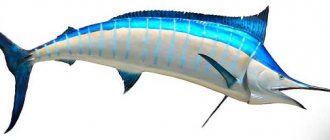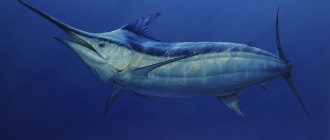Yellow tuna
Found in the Pacific, Indian and Atlantic oceans. It can live in temperate waters, but is more common in the tropics and subtropics. It is a valuable object of industrial fishing. The fish has very tasty meat, but tuna contains mercury. The maximum height recorded was 239 cm and weight 200 kg. Can reach speeds of up to 75 kilometers per hour in open water. This is the fastest tuna fish.
Atlantic tarpon
- Max. speed: 56 km/h
This fish is mainly found in the lagoons of West Africa and near the Atlantic coast of South America. Tarpon weighs from 70 to 180 kg and has a maximum size of 2.5 m. In addition, it can live for almost 50 years. Anglers prize this fish for the sporting aspect of fishing: jumping out of the water when touching the bait. Atlantic tarpon can reach speeds of up to 56 km per hour.
Marlin
Marlins live in the coastal waters of the Pacific Ocean and the Indian Ocean. These are quite large fish, whose weight can reach up to 750 kilograms. Due to the taste of the meat, they are a valuable object for sport and commercial fishing. They have very high speed. Striped marlin reaches speeds of up to 77 km/h, and black marlin up to 81 km/h. But this is not yet the fastest fish in the world.
Springbok
Maximum speed: 88 km/h. Scientific name: Antidorcas marsupialis
The springbok is one of more than 90 species of antelope found exclusively in southwest Africa. There are three known subspecies of springbok.
First described in 1780, it is only recently that the springbok (along with the saiga) has been recognized as an entirely different antelope species. With a top speed of 88 km/h, the springbok is perhaps the fastest antelope and the second fastest land animal on earth.
Springbok antelope can live without water for months, and in some cases years, as they supplement their water requirements by consuming succulent plants and shrubs. They often display a peculiar movement known as pronking, in which the individual leaps into the air in a bow with legs spread apart.
It has been suggested that such activity is carried out either to confuse the predator or to raise an alarm.
Horse mackerel
In the public consciousness, representatives of the horse mackerel genus are associated with canned fish. Due to the high taste of their meat, they are one of the main objects of industrial fishing. They live in the subtropical and tropical waters of the World Ocean. But few people know that it is quite difficult to catch them. First of all, because they develop high speed. It reaches up to 80 kilometers per hour.
Mako shark
- Maximum length : 3.2 meters
- Maximum weight : 135 kg
- Average speed 75 km/h.
Among the shark species, the mako shark is the fastest. This species lives in temperate and tropical seas around the world. It feeds on bony fish and cephalopods. Swordfish, tuna, bonito mackerel, seabirds and sea turtles can also be caught. Speed is the main trump card when hunting, since the prey simply does not have time to notice them. When chasing prey, it is capable of jumping out of the water more than 9 meters!
This is interesting: TOP 10 interesting facts about animals
sailboat
This marine predatory fish has a wide habitat. It can be found in temperate, tropical and subtropical waters of the World Ocean. Occasionally it comes across Russia, in the area of the Kuril Islands. Despite its very large size (length reaches 4.5 meters), it is the fastest fish in the world. It can reach speeds of up to 112 km/h. The sailboat swims so quickly and well thanks to the unique shape of its fins. When the fish wants to reach maximum speed, the fins are retracted and due to streamlining, the speed of movement increases greatly.
Every fish in the top 10 fastest on planet Earth is a marine fish. But it is unlikely that those who like to fish on Russian rivers and lakes will worry much about this. The sailfish, the fastest fish in the world, is unlikely to be caught by anyone in a Russian reservoir.
The fastest fish in the world
The fastest land animal on earth is the cheetah, capable of reaching speeds of over 100 km/h. But some marine inhabitants have no less speed of movement and dexterity.
The fastest fish in the world are presented to the attention of readers - top 10.
10. Atlantic tarpon Speed up to 50 km/h
Atlantic tarpon opens the top ten fastest fish in the world, which can reach speeds in the water of up to 50 km/h. Tarpon has a distinctive appearance and slightly resembles a large herring. In search of food, tarpon can travel enormous distances in a week. Its food is various mollusks, crustaceans, and young fish of other species that prefer smaller habitats and walk closer to the surface of the water.
9. Tiger shark Speed up to 53 km/h
The tiger shark is one of the most dangerous and fastest marine creatures with a maximum speed of 53 km/h. It is also one of the largest living sharks with a body length of up to 5 meters. Active predators and excellent swimmers, tiger sharks usually patrol their territory slowly, making subtle movements, but become fast and agile when they smell food. During an attack or flight, they are able to instantly develop high speed. Tiger sharks are found offshore, primarily in tropical and subtropical waters around the world.
8. Albula Speed up to 60 km/h
Albula ranks eighth in the list of the fastest fish in the world with a maximum speed of 60 km/h. This is a predatory fish that is found in the waters of tropical and subtropical seas. The size of a large individual can reach 1 meter in length and weight up to 9 kilograms. For the most part, marine life is used as a catch in sport fishing.
7. Swordfish Speed up to 65 km/h
The swordfish is capable of moving in water at a speed of 65 km/h, which allows it to bear the title of one of the fastest fish in the world. It got its name due to its highly elongated and flattened upper jaw, which has the shape of a pointed sword and accounts for up to a third of the length of the entire fish. The swordfish has no pelvic fins, and the tail has a semi-lunar shape, immediately showing the high speed qualities of its owner. As for the dimensions of the sea creature, it can reach 4.55 m in length and weigh 650 kg. Swordfish is found in tropical and subtropical waters of all oceans; it is found sporadically in the Black and Azov Seas, where it appears only in summer. It is the target of fishing, mainly the pelagic longline, and a valuable trophy of sport fishing - trolling. No attacks on humans were recorded until May 2015, when a swordfish in Hawaii attacked fishing boat skipper Rensi Llanes, who harpooned it. The sword pierced the chest and the man died.
6. Blue shark Speed up to 69 km/h
The blue shark is one of the fastest marine predators with a maximum speed of 69 km/h. Large predatory fish are found far from the coast, in the ocean, and near the coastline. But it is more common to see these fish on the open sea, as part of a convoy of ocean-going ships and liners, so the blue shark is considered primarily a pelagic fish. Perhaps this is one of the most numerous species among sharks in the World Ocean, along with such common predators as herring and salmon sharks.
5. Southern bluefin tuna Speed up to 74 km/h
Southern bluefin tuna , with a swimming speed of 74 km/h, ranks fifth in the ranking of the fastest fish in the world. Pacific bluefin tuna are constantly on the move. When they stop, breathing becomes difficult because the gill covers open in accordance with the lateral movements of the body to the left and right. Water passes through the open mouth into the gill cavity only when moving. These are schooling pelagic fish that make long migrations. Sometimes they form schools with similar-sized tuna of other species - longfin, yellowfin, bigeye, striped, etc. The diet is varied and depends on the food supply in the feeding areas. It is based on schooling pelagic fish that live near the surface of the water.
4. Yellow tuna Speed up to 75 km/h
Yellow tuna is one of the fastest fish in the world with a moving speed of 75 km/h. The marine predator is distinguished primarily by its enormous size: it can reach two and a half meters and weigh 200 kilograms. He received his nickname for the corresponding color; his body is colored blue-gray, and yellow-white longitudinal lines run along his back. There are 20 such lines in total. The anal fin of this type of tuna is also colored bright yellow. There is also a long solar stripe running along the sides, but in some individuals it is absent. Yellowfin tuna lives mainly in schools; it feeds on squid, small fish and various crustaceans.
3. Striped marlin Speed up to 77 km/h
Striped marlin opens the top three fastest fish in the world with speeds in the water of up to 77 km/h. It got its name due to the well-defined transverse striping of the body. Extremely rare in the equatorial zone, it undertakes significant migrations, during which this fish moves to higher latitudes in the warm season and returns to warm-water areas of its range in winter. The predator feeds mainly on squid, fish and crustaceans.
2. Horse mackerel Speed up to 80 km/h
Horse mackerel ranks second in the ranking of the fastest fish in the world. The sea animal is capable of developing an impressive speed when swimming, which is equal to 80 km/h. High speed plays a very important role for mackerel, because it is a predator and this helps it to overtake its prey in a short time. It is a schooling fish that moves in the water column and forms schools. It lives in warm waters within the continental shelf, often close to the coast. It breeds in the warm season. It feeds on plankton and small fish, sometimes bottom invertebrates.
1. Sailboat Speed over 100 km/h
The sailfish is the fastest fish in the world, capable of reaching speeds of over 100 km/h.
During a series of tests carried out in one of the fishing camps, the sailboat swam 91 m in 3 s, which is equivalent to a speed of 109 km/h. Unlike the vast majority of bony fish, sailfish and related species of the sailfish and swordfish families effectively use turbulence, that is, water flows around the body not layer by layer, as in laminar movement, but forming fast eddies that help them reduce water resistance. The far-protruding pointed projections of the upper and lower jaws allow the effect of turbulence to be achieved at lower speeds. When swimming fast, the sail folds and stows in a special recess on the back. The anal and long ventral fins are also hidden. When making sharp turns at high speed, the fins rise sharply. Sometimes sailboats drift slowly at the surface of the water with the sail fully extended and protruding above the water. ='text-align:right;'>
Population and species status
Nowadays, active marlin fishing on an industrial scale is carried out in the Indian Ocean. The percentage of global marlin catches is quite high, with Japan and Indonesia being the most active fishers for this fish. Special longline nets are used to catch marlin. Marlin is the dream of every sports fisherman, as well as amateur fisherman.
Despite such high interest, these days most of the marlin caught are released back. Marlin meat is considered a delicacy, which is why they are caught for commercial purposes, which leads to a decrease in the overall number of marlins. In this regard, this fish was listed in the Red Book as a “vulnerable species”.
Film by Oleg Lyadenko. In search of MARLIN
Golden eagle
Another representative of birds among the fastest animals in the world is the golden eagle. The bird is a formidable predator in the Northern Hemisphere. Prefers life in the mountains, although it can also live on the plains.
The golden eagle is a large representative of the hawk family. He is the largest among the eagles. The bird's body length reaches 93 cm, its wingspan is over 2 m. The weight of the golden eagle is more than 6 kg. The bird is armed not only with a beak and claws, but also with eagle vision: the golden eagle notices prey from a distance of 2 km.
Golden eagle: Wikipedia
The golden eagle's tactics for catching prey vary. In clear weather, a large eagle soars high above the ground, and, having spotted a prey, quickly dives towards it. The speed of such a fall reaches 320 km/h. In cloudy weather, the golden eagle can ambush on a tall tree.
With age, the bird's hunting qualities improve: if a young golden eagle catches only 1 out of 20 hares, then an experienced hunter practically makes no mistakes.
Bonito
Bonito
Bonito, the common name for fish of the bonito (or sard) genus, which includes species such as the Atlantic, Australian, Oriental and Chilean bonito. Representatives of the genus are capable of jumping at a speed of about 65 km/h. Bonito have a body length of about 1 m.











